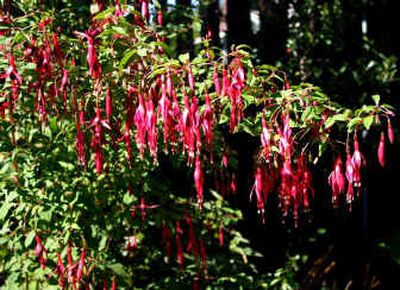It”s all about your plants

Eve Thyrum knows all the proper botanical Latin names of all the plants in her garden, but tends to avoid using them when she’s not talking to hard-core gardeners like herself.
Latin sometimes puts off visitors, she says. “People tend to call you a plant snob,” says Thyrum, a graduate of the two-year horticulture program at the famed Longwood Gardens in Kennett Square, Pa.
Snobs or not, gardeners around the world know that learning Latin names will help them learn more about their plants, pick the proper varieties and avoid the confusion that can come with some common botanical names.
Sometimes, it’s because a single plant has several common names — Datura stramonium, a common weed, is known as devil’s apple, jimson weed, stinkweed and devil’s trumpet. Other times, names are misleading — mountain laurel, also known as calico bush, is not even a true laurel. To make it more confounding, mountain laurel, Kalmia latifolia, is poisonous, while true laurel, Laurus nobilis (also known as sweet bay) is not and used in cooking.
If you are collecting a certain type of plant, such as orchids or begonias, using botanical Latin also will keep you from buying duplicates that can have more than one common name.
While it may look and sound intimidating, the Latin is no more difficult to learn than the common names, especially if you’re new to gardening.
Living, breathing Latin
Efforts to standardize plant names in the far-flung world of botany began long ago. In the 18th century, Swedish naturalist Carl Linnaeus broke down the plant world into genera, and more precisely, species, which are always printed in italic type. Linnaeus used Greek and Latin words, prefixes and suffixes when creating his nomenclature. He created many Latinlike words with people’s names and other descriptors, a tradition that continues today. For example, the genus Fuchsia is named after 16th-century botanist Leonard Fuchs.
Despite its age, botanical Latin is no dead language. Its evolution is being constantly driven by advances in science that debunk previous classifications, the introduction of new cultivars, and commercial plant breeders who give commercial names to their cultivars.
Over the years, DNA research has found that many plants once thought to be related are not, causing some confusion in the world of botanical Latin. “Before you blink an eye, the genus has changed,” Thyrum says. Over the last few decades, botanists have changed the scientific names of chrysanthemums, coleus and sedums.
“The science keeps getting better,” says horticultural author Rick Darke, though change isn’t always unchallenged. Changing the classification of the chrysanthemum genus to the dendranthema caused an uproar in the nursery and gardening world, says Darke. “The world looked at this and said, ‘You’ve got to be kidding,”’ Darke says.
With the introduction of new plants making things even more complicated, a term signifying the “cultivar” of the species was added in 1953. Cultivar is an abbreviation of “cultivated variety.”
Botanical Latin has become further complicated in the last several years with the introduction of commercial names associated with specific cultivars marketed by nurseries including Star Roses, or Endless Summer Hydrangea. It’s easy for a customer to ask for a brand name in a garden center, but botanists are arguing over where to put the commercial name in the nomenclature. Some put it after the cultivar, and not between single quotes, others put the commercial name before the cultivar.
That one remains to be resolved. What would Linnaeus do?